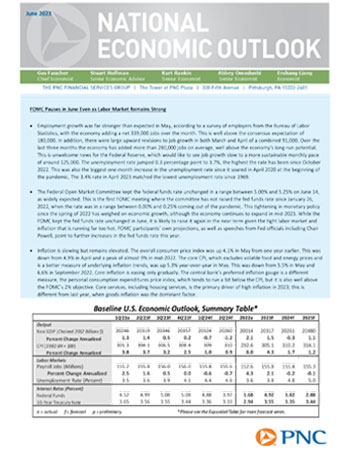The information contained in this site, is to the best of PNC Bank's knowledge, correct and accurate, but PNC Bank does not represent, warrant or guarantee its accuracy. Any downloading of material contained in this site or of any site linked to this site may be a violation of federal trademark and copyright laws.
PNC National Economic Outlook
March 2024
FOMC Sets Stage for Rate Cuts Later This Year as Labor Market Remains Very Strong in Early 2024
The U.S. economy added a strong 275,000 jobs in February, according to a survey of employers from the Bureau of Labor Statistics. However, there were big downward revisions to job growth in January and February of a combined 167,000. Over the past three months job growth has averaged 265,000, well above the pre-pandemic pace. The private sector added 223,000 jobs in February, up from 177,000 in January.
The unemployment rate rose to 3.9% in February from 3.7% in the previous three months. The unemployment rate has been below 4% for more than two straight years, the longest-such stretch since the late 1960s.
Average hourly earnings rose just 0.1% in February from January, and wage growth in January was revised lower, to 0.5% from 0.6%; there was also a downward revision to wage growth in December. On a year-over-year basis average hourly earnings were up 4.3% in February, down from 4.4% in January (after revisions). Softening wage growth is contributing to a slowing in inflation.
The personal consumption expenditures price index increased 0.3% in February after rising 0.4% in January. The core PCE price index, excluding food and energy prices and the Federal Reserve’s preferred inflation measure, rose 0.3% in February (0.26% before rounding), down from 0.5% monthly core inflation in January.
On a year-over-year basis overall PCE inflation was 2.5% in February, up from 2.4% in January, but down from above 3% as recently as September 2023, and a cyclical peak of above 7% in mid-2022.
Core PCE inflation was 2.8% year-over-year in February, down from 2.9% in December, and above 3% as recently as November 2023. Core PCE inflation peaked at above 5% in mid-2022. Inflation remains above the Federal Reserve’s 2% objective, but is slowing.
With a softening in inflation the Federal Open Market Committee is signaling that it expects to cut the federal funds rate, the committee’s key short-term policy rate, at some point this year. The FOMC announced no change to the fed funds rate following its policy meeting on March 20. But the Summary of Economic Projections, or dot plot, released following the meeting points to a few rate cuts in 2024.
The median projection of the fed funds rate at the end of 2024 is 4.6%, suggesting three 25 basis point cuts in the fed funds rate this year. But ten participants showed three or more rate cuts this year, while nine showed two or fewer, indicating that participants are about evenly split between 2 and 3 rate cuts in 2024.
The median projected fed funds rate at the end of 2025 was 3.9% in the March 20 dot plot, compared to 3.6% in the previous one, in mid-December.


